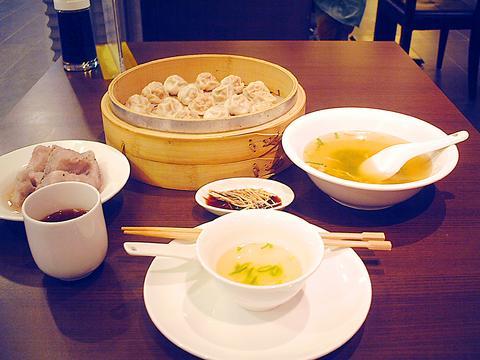Dian Shui Lou puts their xiao long bao (NT$150) and soup baozi (NT$250) at the top of their menu for a very good reason; the tiny delicacies are some of the best things on offer. This spanking new establishment across from the Ritz Taipei Hotel on Minchuan East Road is likely to see considerable traffic from that hotel and may well become a favorite lunchtime destination for the local business crowd hungry for dim sum.
As baozi go, Dian Shui Lou's are a bit unconventional. Their diminutive size prevents them from holding much soup, and so a bowl of broth is brought to the table to accompany each order. A friendly member of the wait staff named Ms. Kao instructed me to place two or three baozi in my bowl of soup, let them swim a minute, eat and repeat. The only problem, is that a tray of some 20 is only enough for one hungry person. Better to order two or else delve deeper into the menu.
Those who can handle their spice will enjoy Dian Shui Lou's hung shao beef noodles (NT$160). Again, dainty dumplings swim in soup, but these are packed powerfully with a spicy punch. Another item on the menu creating a lot of "mmmm's" is Dian Shui Lou's sweet and sour soup. Several types of tofu share the bowl with bits of shredded pork, carrots and sprouts and finds a perfect balance of flavors.

PHOTO: DAVID MOMPHARD, TAIPEI TIMES
Among the side dishes brought to your table by an attentive wait staff is a tasty taro. These dishes aren't the tiny dishes you're accustomed to seeing in local restaurants that sit atop shelves all day waiting to be picked. They're larger portions meant for up to four people. The taro the is best of the ones I've tried, but they seem to change each time they tray is brought around.
While the place is quite well-appointed and immaculate, it still has the feeling of a place ready to serve the masses rather than coddle small tables of diners. The layout is big and open and the servings are large enough for four people. Go with several friends or workmates; it's not quite the place to impress a date.

The canonical shot of an East Asian city is a night skyline studded with towering apartment and office buildings, bright with neon and plastic signage, a landscape of energy and modernity. Another classic image is the same city seen from above, in which identical apartment towers march across the city, spilling out over nearby geography, like stylized soldiers colonizing new territory in a board game. Densely populated dynamic conurbations of money, technological innovation and convenience, it is hard to see the cities of East Asia as what they truly are: necropolises. Why is this? The East Asian development model, with

June 16 to June 22 The following flyer appeared on the streets of Hsinchu on June 12, 1895: “Taipei has already fallen to the Japanese barbarians, who have brought great misery to our land and people. We heard that the Japanese occupiers will tax our gardens, our houses, our bodies, and even our chickens, dogs, cows and pigs. They wear their hair wild, carve their teeth, tattoo their foreheads, wear strange clothes and speak a strange language. How can we be ruled by such people?” Posted by civilian militia leader Wu Tang-hsing (吳湯興), it was a call to arms to retake

Desperate dads meet in car parks to exchange packets; exhausted parents slip it into their kids’ drinks; families wait months for prescriptions buy it “off label.” But is it worth the risk? “The first time I gave him a gummy, I thought, ‘Oh my God, have I killed him?’ He just passed out in front of the TV. That never happens.” Jen remembers giving her son, David, six, melatonin to help him sleep. She got them from a friend, a pediatrician who gave them to her own child. “It was sort of hilarious. She had half a tub of gummies,

The wide-screen spectacle of Formula One gets a gleaming, rip-roaring workout in Joseph Kosinski’s F1, a fine-tuned machine of a movie that, in its most riveting racing scenes, approaches a kind of high-speed splendor. Kosinski, who last endeavored to put moviegoers in the seat of a fighter jet in Top Gun: Maverick, has moved to the open cockpits of Formula One with much the same affection, if not outright need, for speed. A lot of the same team is back. Jerry Bruckheimer produces. Ehren Kruger, a co-writer on Maverick, takes sole credit here. Hans Zimmer, a co-composer previously, supplies the thumping